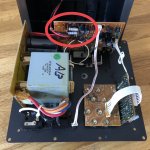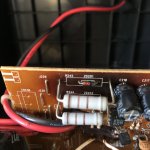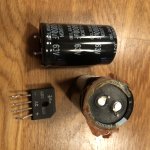Hi All,
I need advice on a fried subwoofer that a friend gave me. It is a Cerwin Vega! HTS10A.
I noticed that the 2A fuse in the power plug was blown, so I bought 10. They immediately blow upon turning the sub on.
So I pulled out the plate amp to inspect the PCBs. The speaker pops, good.
I inspected the amp PCB and noticed an overheated area near where the speaker wires are soldered. There are to large resistances and two zener diodes at the heart of the toasted zone. Bingo!
So here are my questions:
I bought a fried REL sub a few years ago and put in a Dayton Audio 250W RMS plate amp. I love this sub that forced me to put my turntable on a heavy plate of tempered glass, suspended in the air with spectra kite line from the ceiling two floors up. I also had to suspend and dampen the cables (power and phono output). After trying just about everything (magnetic, floating, elastics, pillows, balloons,…), that was the only system that I found would stop the feedback. A pure joy to listen to! I can post solution if interesting.
I need advice on a fried subwoofer that a friend gave me. It is a Cerwin Vega! HTS10A.
I noticed that the 2A fuse in the power plug was blown, so I bought 10. They immediately blow upon turning the sub on.
So I pulled out the plate amp to inspect the PCBs. The speaker pops, good.
I inspected the amp PCB and noticed an overheated area near where the speaker wires are soldered. There are to large resistances and two zener diodes at the heart of the toasted zone. Bingo!
So here are my questions:
- The zeners or the large resistors?
- if the zeners, how do I determine their type or voltage?
- What wattage of resistors?
- I really appreciate any feedback that can allow me to repair this. Thank you.
I bought a fried REL sub a few years ago and put in a Dayton Audio 250W RMS plate amp. I love this sub that forced me to put my turntable on a heavy plate of tempered glass, suspended in the air with spectra kite line from the ceiling two floors up. I also had to suspend and dampen the cables (power and phono output). After trying just about everything (magnetic, floating, elastics, pillows, balloons,…), that was the only system that I found would stop the feedback. A pure joy to listen to! I can post solution if interesting.
Attachments
Last edited:
Thank you BSST !
Unfortunately, that model appears to be quite different near the output. There is only one zener diode. On mine, there are two, with large (5W) resistors.
I will reach out to Cerwin Vega!, though I do not expect support on such an old model.
Thanks again,
Paul
Unfortunately, that model appears to be quite different near the output. There is only one zener diode. On mine, there are two, with large (5W) resistors.
I will reach out to Cerwin Vega!, though I do not expect support on such an old model.
Thanks again,
Paul
I unsoldered the 3 leads of the power supply and powered up with a new fuse. It blew. PSU problem.
The power supply board looks simple: a transformer (9 pin, most likely OEM), two 6800uF 63v caps, what looks like a bridge rectifier and a rectangular yellow component (a large 11K resistor?).
The problem may also be on the AC interface (110v socket, voltage selector, on/off).
The toasted area on the amp PCB indicates that the amp was driven too hard and the PCB browned from radiant heat from the resistors. Could have happened over time… Most likely OK, the PSU failing first.
What component in your opinion would be most suspect on a PSU? A shorted out bridge rectifier? The electrolytic caps? Hopefully not the transformer :-(
Please advise. Much appreciated.
The power supply board looks simple: a transformer (9 pin, most likely OEM), two 6800uF 63v caps, what looks like a bridge rectifier and a rectangular yellow component (a large 11K resistor?).
The problem may also be on the AC interface (110v socket, voltage selector, on/off).
The toasted area on the amp PCB indicates that the amp was driven too hard and the PCB browned from radiant heat from the resistors. Could have happened over time… Most likely OK, the PSU failing first.
What component in your opinion would be most suspect on a PSU? A shorted out bridge rectifier? The electrolytic caps? Hopefully not the transformer :-(
Please advise. Much appreciated.
RESOLVED !
(I think…)
I desoldered the bridge rectifier first and tested it. PASS!
Next, I desoldered the caps to test them. They appear to have leaked! No need testing them, pretty obvious. The inside shakes around. Yup, toasted dry.
BINGO !
This is a great forum. Thanks for the advice. I think this baby is salvaged ;-)
(I think…)
I desoldered the bridge rectifier first and tested it. PASS!
Next, I desoldered the caps to test them. They appear to have leaked! No need testing them, pretty obvious. The inside shakes around. Yup, toasted dry.
BINGO !
This is a great forum. Thanks for the advice. I think this baby is salvaged ;-)
Attachments
Hi! Dealing with the same problem with the same sub. Did swapping the caps clear the issue for you long term?
Yes, absolutely! That sub works fine again with no issues.
When I arrived in town in the fall, the sub there was also dead too. Not again! It is a really nice and tight British REL sub bought used with a replacement plate amp I bought, a 250W Dayton Audio. Again, no product support for their Chinese built disposable items whatsoever other than “Sorry, just buy a new one” Oh yeah? Sorry, no support your old, then no new purchases from you! Tell them this politely and just move one…
This time, it was a tiny electrolytic cap that had failed in the AutoOn circuit. Very subtle bowing and slight splitting of the scored cross on the end plate, no leakage. How I knew? Fuse OK and there was rectified power that ended there. So, also fixed ;-) YEAH !
CONCLUSIONS:
I am no electronic expert by any means, but what I have learned is not to be fearful and that you have not much to lose and all to gain:
1. Observe carefully. Visual inspection is foremost. Look for overheating (discolouration, smells, cracking,..), leakage,…it can subtle at times but most of the time, there are clues to be found.
2. Identify all possible faulty components and then proceed to change them one by one in order of probability: fuses, solder joints, electrolytic capacitors, power transistors, diodes, transformers,…
3. Basic voltage checks at key locations: Mains, after fuse, transformer primary and secondary, after rectification,… work your way through to the heat sink at output end.
4. CAUTION probing when powered up and always fully discharge caps that can maintain lethal charges, even powered off!
5. Have faith in yourself and good luck may come your way. It is most rewarding too.
When I arrived in town in the fall, the sub there was also dead too. Not again! It is a really nice and tight British REL sub bought used with a replacement plate amp I bought, a 250W Dayton Audio. Again, no product support for their Chinese built disposable items whatsoever other than “Sorry, just buy a new one” Oh yeah? Sorry, no support your old, then no new purchases from you! Tell them this politely and just move one…
This time, it was a tiny electrolytic cap that had failed in the AutoOn circuit. Very subtle bowing and slight splitting of the scored cross on the end plate, no leakage. How I knew? Fuse OK and there was rectified power that ended there. So, also fixed ;-) YEAH !
CONCLUSIONS:
I am no electronic expert by any means, but what I have learned is not to be fearful and that you have not much to lose and all to gain:
1. Observe carefully. Visual inspection is foremost. Look for overheating (discolouration, smells, cracking,..), leakage,…it can subtle at times but most of the time, there are clues to be found.
2. Identify all possible faulty components and then proceed to change them one by one in order of probability: fuses, solder joints, electrolytic capacitors, power transistors, diodes, transformers,…
3. Basic voltage checks at key locations: Mains, after fuse, transformer primary and secondary, after rectification,… work your way through to the heat sink at output end.
4. CAUTION probing when powered up and always fully discharge caps that can maintain lethal charges, even powered off!
5. Have faith in yourself and good luck may come your way. It is most rewarding too.
Last edited:
- Home
- Amplifiers
- Solid State
- Subwoofer amplifier repair



